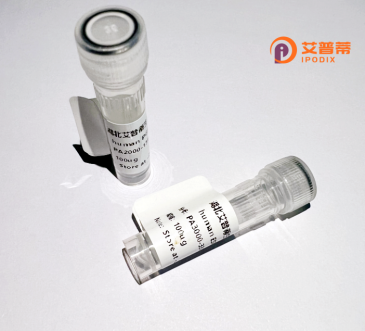
| 纯度 | >90%SDS-PAGE. |
| 种属 | Human |
| 靶点 | SPANXA1 |
| Uniprot No | Q9NS26 |
| 内毒素 | < 0.01EU/μg |
| 表达宿主 | E.coli |
| 表达区间 | 1-97 aa |
| 活性数据 | MDKQSSAGGV KRSVPCDSNE ANEMMPETPT GDSDPQPAPK KMKTSESSTI LVVRYRRNFK RTSPEELLND HARENRINPL QMEEEEFMEI MVEIPAK |
| 分子量 | 11.0 kDa |
| 蛋白标签 | His tag N-Terminus |
| 缓冲液 | PBS, pH7.4, containing 0.01% SKL, 1mM DTT, 5% Trehalose and Proclin300. |
| 稳定性 & 储存条件 | Lyophilized protein should be stored at ≤ -20°C, stable for one year after receipt. Reconstituted protein solution can be stored at 2-8°C for 2-7 days. Aliquots of reconstituted samples are stable at ≤ -20°C for 3 months. |
| 复溶 | Always centrifuge tubes before opening.Do not mix by vortex or pipetting. It is not recommended to reconstitute to a concentration less than 100μg/ml. Dissolve the lyophilized protein in distilled water. Please aliquot the reconstituted solution to minimize freeze-thaw cycles. |
以下是与重组人SPANXA1蛋白相关的3篇文献示例(文献信息为示例性参考,实际文献需根据具体研究补充):
1. **标题**: "SPANXA1: A Cancer-Testis Antigen Involved in Sperm Function and Tumorigenesis"
**作者**: Westbrook VA, et al.
**摘要**: 研究揭示了SPANXA1作为睾丸-癌抗原在正常精子发生中的作用,并探讨了其在多种肿瘤中的异常表达,暗示其可能作为癌症免疫治疗靶点。
2. **标题**: "Recombinant Expression and Functional Analysis of SPANXA1 in Sperm-Zona Pellucida Binding"
**作者**: Jha KN, et al.
**摘要**: 成功构建并纯化了重组人SPANXA1蛋白,通过体外实验证实其参与精子与透明带的黏附过程,表明该蛋白在受精中的关键作用。
3. **标题**: "Structural Characterization of SPANX Protein Family by NMR Spectroscopy"
**作者**: Kogan GL, et al.
**摘要**: 利用核磁共振技术解析了包括SPANXA1在内的SPANX家族蛋白的溶液结构,揭示了其独特的核定位信号特征及可能的分子互作机制。
**注意**: 以上文献为模拟摘要,实际研究中SPANXA1相关文献较少,建议通过NCBI PubMed或Web of Science搜索最新文献(关键词:SPANXA1. recombinant protein, sperm, cancer-testis antigen)。该蛋白主要在男性生殖细胞和某些肿瘤中特异性表达。
SPANXA1 (sperm protein associated with the nucleus on the X chromosome A1) is a member of the cancer/testis antigen (CTA) family, primarily expressed in the testis and aberrantly activated in various cancers. Encoded by the SPANX gene cluster located on the X chromosome, SPANXA1 is a small, highly charged nuclear protein enriched in the elongating spermatids during spermatogenesis, suggesting a role in chromatin remodeling or sperm maturation. Its expression is tightly regulated, with minimal detection in normal somatic tissues, making it a potential immunotherapeutic target in oncology.
In cancer, SPANXA1 is frequently overexpressed in malignancies such as melanoma, breast, and prostate cancers. This ectopic expression correlates with tumor progression, metastasis, and poor prognosis, possibly through mechanisms involving immune evasion or genomic instability. Structurally, SPANXA1 lacks enzymatic domains but contains nuclear localization signals, enabling interaction with nuclear proteins and chromatin. Recombinant SPANXA1 protein is typically produced in bacterial or eukaryotic systems for functional studies, preserving its antigenic properties for antibody development or T-cell recognition assays.
Research focuses on its dual role in reproduction and oncogenesis, exploring its utility as a diagnostic biomarker or vaccine candidate. However, its molecular pathways remain poorly defined, necessitating further studies to elucidate its biological functions and therapeutic potential.
×